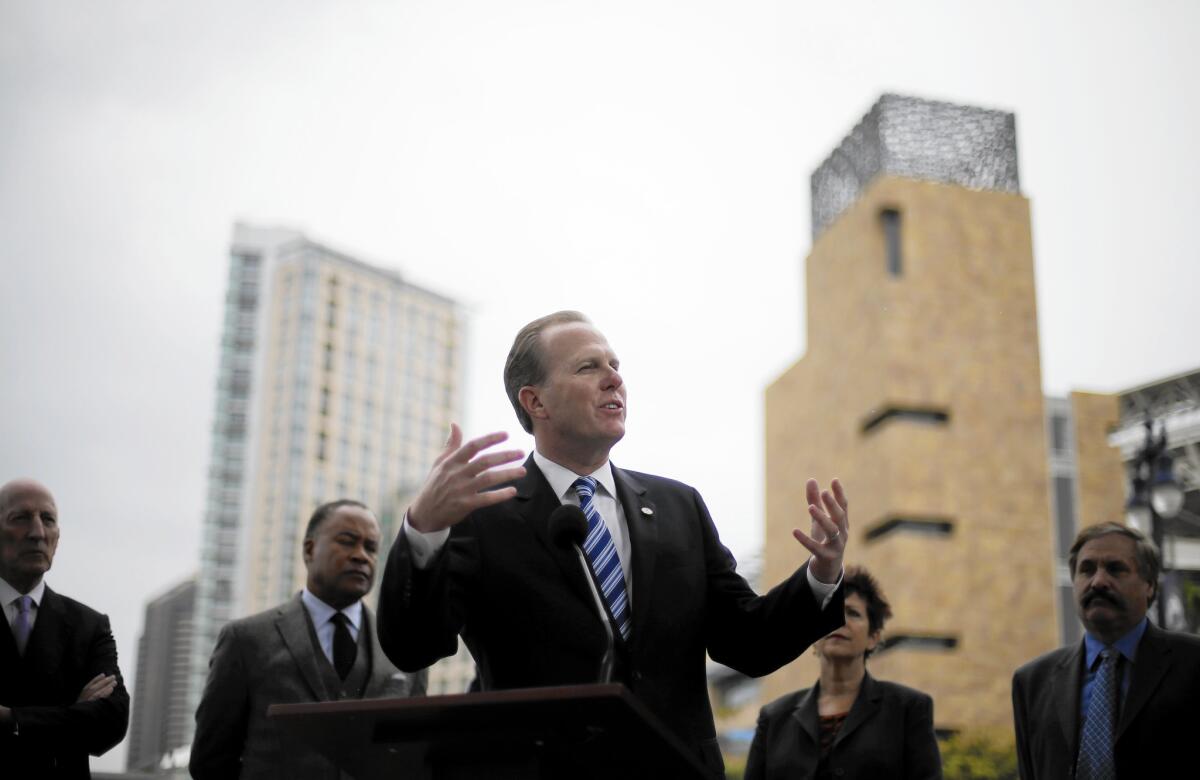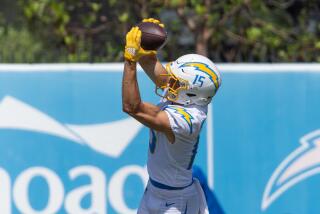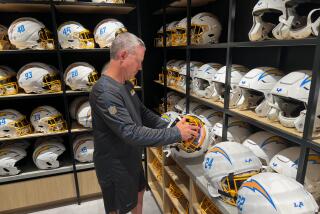San Diego consults its civic playbook on stadium situation

SAN DIEGO — Officials here are accustomed to doing civic business with a high degree of caution and deliberation, careful to avoid political conflict and legal wrangling whenever possible.
But the Chargers’ surprise announcement that the team may abandon San Diego for Carson has city leaders racing against a short deadline to devise a plan to build a new football stadium — a plan that, regardless of its specifics, will be controversial and expensive, and will invite lawsuits.
It’s all very un-San Diego, and it reflects the angst over the prospect of losing an NFL franchise to a suburb of Los Angeles.
“We’re America’s Finest City,” said Dan McLellan, who helped form a new fan group, Save Our Bolts. “We’re better than Carson.”
Even if the mayor and City Council find a site and a financing plan to build a stadium, the next task may be more daunting: Winning support from fiscally conservative voters who roundly rejected a half-cent sales tax in 2010 to improve police and fire protection and fix potholes.
A recent poll showed a majority of San Diego residents favor keeping the Chargers but also oppose using public funds for a stadium.
On Monday night, the public will get a chance to vent at a scheduled three-hour meeting of the stadium advisory committee that was appointed in January by Mayor Kevin Faulconer. The hearing, the committee’s only public session, is set for 6 p.m. at a Qualcomm Stadium lounge.
McLellan, a former Chargers beat reporter for CBSSports.com, hopes to attract several thousand Charger fans to a 5 p.m. rally in the Qualcomm parking lot.
The Feb. 19 announcement that the Chargers and Oakland Raiders jointly plan a $1.7-billion stadium in Carson shocked the mayor and other officials.
The normally mild-mannered Faulconer made little effort to hide his annoyance. He ordered his stadium advisory committee to have a recommendation on a site and financing plan within 90 days, not six to nine months as initially requested.
The committee, composed of nine civic and business leaders, picked up the new tempo, announcing that it may complete its work even faster. At Faulconer’s invitation, the mayor and Chargers President Dean Spanos met privately for an hour.
Since the Carson bombshell, two members of the San Diego City Council have suggested ways to hasten the local process by having city staffers study the money issues involved. Two others made suggestions about financing.
A county supervisor told the advisory committee that the county would be willing to make a “bridge” loan to help the city begin the project.
The council unanimously passed a resolution vowing to keep the Chargers, “a source of civic pride and inspiration.” Though symbolic, the gesture represents the greatest show of support from City Hall in the 14 years the Chargers have been campaigning for a stadium to replace Qualcomm.
“Chargers momentum seems to be building,” said sports broadcaster Lee “Hacksaw” Hamilton, the former radio voice of the Chargers. “Get the site, let the county create a bridge fund, have Spanos commit his share. Get it done!”
Others see the city rushing toward an unwise financial commitment.
“WARNING: Magic Budget Fairy cited at City Hall wearing a Chargers jersey,” tweeted former Councilman Carl DeMaio.
Faulconer called on the advisory committee to choose between the 166-acre Qualcomm site in Mission Valley and a parcel in the eastern stretch of downtown where the Chargers had once proposed a combination stadium and convention center annex. Both sites have been discussed in the past.
The Qualcomm property is owned by the city and is next to Interstate 8, but a portion of it sits atop a gas plume, leakage from a nearby “tank farm.” Mitigation measures are underway to keep the leak from polluting an aquifer.
The downtown site is near Petco Park and the new central library, but building a stadium would require relocating a maintenance and administrative facility operated by the Metropolitan Transit System. Relocating the bus yard could cost upward of $100 million and delay construction of a stadium by five to seven years, the system’s chief executive warned last week.
The advisory committee appears to be focusing on the Qualcomm site.
Supervisor Ron Roberts told the committee to consider adding commercial development to the sprawling site to help pay for a new stadium. A multistory parking structure would be needed to provide parking for the existing stadium while the new stadium is under construction, he said.
Also, Roberts said the committee should make a list of all possible funding sources — including naming rights and seat licenses — and begin negotiations with the Chargers about their share of the costs. Among the committee members is a leasing executive who is a veteran of high-stakes negotiations.
Councilman Mark Kersey noted that there have been multiple plans put forth by the Chargers and others in the last 14 years. “We’re not reinventing the wheel here,” he said.
The Chargers’ lease at Qualcomm is year to year. The team has promised to remain for the 2015 season but made no promises for 2016 or beyond.
At a cost of $15 million, the Chargers’ ownership has studied and presented multiple plans in the last 14 years. The city has also studied various possibilities. But none of the plans made it to the ballot.
Only recently has the city emerged from one of the worst financial stretches in its history, a fiscal debacle created by a spiraling pension debt, political upheaval and the national economic collapse.
“I do not think it would be prudent or honest for me to say to taxpayers: ‘We can’t resurface our roadways, but we can finance a stadium,’” then-Mayor Jerry Sanders said at one point.
But now the city’s economic picture is brighter, Sanders is chief executive of the San Diego Regional Chamber of Commerce, and the chamber’s chief operating officer, Aimee Faucett, is on Faulconer’s stadium advisory committee.
Officials appear to agree that it is not realistic to expect voters to provide the two-thirds majority needed to approve a sales-tax or room-tax increase. The hunt is on for alternative financing plans.
Though no figures have been released for San Diego, estimates suggest an NFL stadium would cost a minimum of $800 million and probably much more. Political opposition to any public subsidy is expected to be fierce.
Chargers special counsel Mark Fabiani reminded the advisory committee that an attempt by the City Council to sidestep the two-thirds requirement in financing a convention center expansion was struck down by an appeals court.
Even if the preferred plan does not legally require voter approval, Faulconer has promised that it will be presented to voters. That was the strategy used in 1998 in an advisory vote on Petco Park. Although the measure was supported by 60% of voters, construction was delayed for two years by 16 lawsuits.
When he named the members of his advisory committee, Faulconer said a public vote could be held in November 2016. That came after the announcement by the owner of the St. Louis Rams that he plans to build a $1.86-billion stadium in Inglewood, possibly as a precursor to relocating his team.
The Carson revelation sent the level of urgency soaring in San Diego. Now the talk at City Hall is about a special election, a move that would add controversy and expense to an issue that already has plenty of both.
McLellan is urging San Diegans, during the planned rally, to show their enthusiasm for keeping the Chargers in town. Later, while speaking to the committee, he said, people should be passionate but not accusatory or rambling.
He wants Charger enthusiasts to think of the committee session as akin to Monday Night Football.
“That’s the kind of emotion we need to tap into,” he said. “After 14 years, the fans need to be heard before it’s too late.”
Twitter: @LATsandiego
More to Read
Sign up for Essential California
The most important California stories and recommendations in your inbox every morning.
You may occasionally receive promotional content from the Los Angeles Times.










